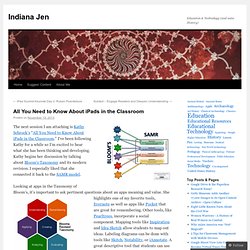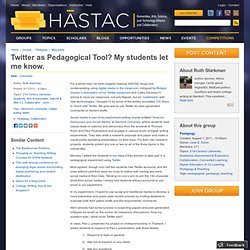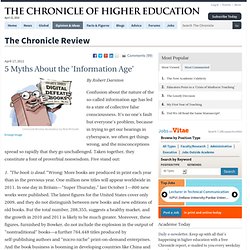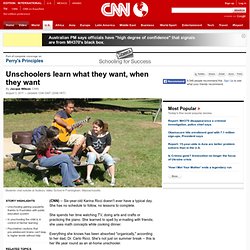

How to Create a Form and Grade it Automatically with Flubaroo's New Version. All You Need to Know About iPads in the Classroom. All You Need to Know About iPads in the Classroom The next session I am attaching is Kathy Schrock’s “All You Need to Know About iPads in the Classroom.”

I’ve been following Kathy for a while so I’m excited to hear what she has been thinking and developing. Kathy begins her discussion by talking about Bloom’s Taxonomy and its modern revision. I especially liked that she connected it back to the SAMR model. Looking at apps in the Taxonomy of Bloom’s, it’s important to ask pertinent questions about an apps meaning and value. Tools, Evernote as well as apps like Pocket that are great for remembering. There are thousands of applications that you can use. Like this: Like Loading...
About Jennifer Carey My name is Jennifer Carey and I am a student and educator of the human condition. iPad Presentation Support Page - Kathy Schrock's iPads4teaching.
EdTech. Tech literacy. Twitter as Pedagogical Tool? My students let me know. For a while now I’ve been eagerly reading HASTAC blogs and contemplating using digital media in the classroom.

Intrigued by Bridget Draxler’s description of her Twitter classroom and Cathy Davidson's advice to have my classroom, not only flipped, but do “cartwheels” with new technologies, I thought I’d try some of the widely circulated 100 Ways to Teach with Twitter. My goal was to use Twitter for peer-generated comments on student drafts. Social media is part of my sophomore writing course entitled “Science, Democracy and Social Media” at Stanford University, where students read classic texts on science and democracy from the ancients to Thomas Kuhn and Paul Feyerabend and engage in various kinds of digital writing experiments.
They also write a research proposal and paper and make a visual public speaking presentation on their topic. For their own research projects, students picked any one or two or all of the three topics in the course title. 1) Respond to topic in general. Instant Messaging. Disposable Twitter Accounts for Classroom Use. Twitter comes up frequently on ProfHacker.

We write about Twitter in the classroom, Twitter for conference (and unconference) backchannels, and using Twitter as part of a web presence strategy. One of my first ProfHacker posts was all about how and why academics should consider using the service. When it comes to the classroom, however, there are complications with requiring Twitter. These include: Some professors are uncomfortable requiring students to use a commerical service for their classes. In my digital humanities classes, I do require students to use Twitter so they can follow the most dynamic conversations happening among practitioners in the field. I. The second paragraph of the assignment lays out the way that I manage some of the potential problems with using Twitter in the classroom.
Why Twitter and Facebook Are Not Good Instructional Tools. 5 Myths About the 'Information Age' - The Chronicle Review. By Robert Darnton Confusion about the nature of the so-called information age has led to a state of collective false consciousness.

It's no one's fault but everyone's problem, because in trying to get our bearings in cyberspace, we often get things wrong, and the misconceptions spread so rapidly that they go unchallenged. Taken together, they constitute a font of proverbial nonwisdom. Five stand out: 1. 2. 3. 4. 5. I mention these misconceptions because I think they stand in the way of understanding shifts in the information environment. Last year the sale of e-books (digitized texts designed for hand-held readers) doubled, accounting for 10 percent of sales in the trade-book market. Many of us worry about a decline in deep, reflective, cover-to-cover reading.
In studies of culture among the common people, Richard Hoggart and Michel de Certeau have emphasized the positive aspect of reading intermittently and in small doses. Unschoolers learn what they want, when they want. Students chat outside at Sudbury Valley School in Framingham, Massachusetts.

Unschooling gaining popularity thanks to frustration with public education systemIn unschooling the child is in control of his/her learningPsychiatrist cautions that pre-adolescent brains can't leap to higher levels without help (CNN) -- Six-year-old Karina Ricci doesn't ever have a typical day. She has no schedule to follow, no lessons to complete. She spends her time watching TV, doing arts and crafts or practicing the piano. She learned to spell by e-mailing with friends; she uses math concepts while cooking dinner. Everything she knows has been absorbed "organically," according to her dad, Dr. "It's incredible how capable she is," Ricci said in a phone interview from his home in Toronto, Ontario.
Experts say there are about 2 million home-educated students in the U.S., and Ricci estimates 10% adhere to unschooling ideals. "Our education system as a whole is, to me, in a very delicate and precarious place.